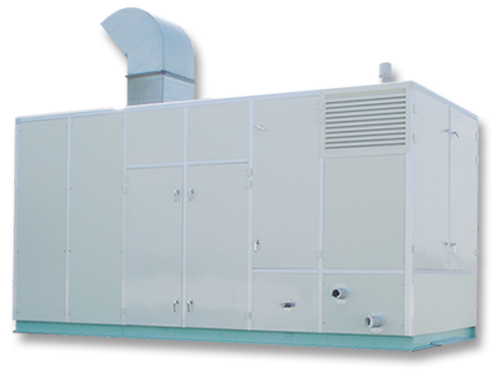
business field
Industrial development and improved human well-being have led to significant energy consumption. Consequently, in order to remove generated heat and maintain an appropriate temperature, it is required to cool the remaining heat. Cooling requires a cooling medium. Therefore, cooling towers uses the most abundant water in nature, with the most efficient heat transfer method that is, evaporation to cool and recirculate the heated water using mechanical power. In other words, cooling towers are the ultimate heat outlet and the safest and most efficient heat exchanger.
The fundamental principle of cooling towers is heat transfer based on latent and sensible heat of vaporization.
In other words, water evaporates, drawing latent heat of vaporization from its surroundings and cooling the surroundings.
Air is cooled by sensible heat due to the temperature difference between water and air.
The tower is designed to maximize the water's air retention time, maximize the contact surface area,
and increase airflow to maximize contact between water and air, to cause high evaporation rates.

| TOWER STRUCTURE PART (Above basin) |
Cooling towers should be able to withstand dead loads and operating loads, and maintain their structural integrity even under diverse external atmospheric conditions and internal storms. | |
|---|---|---|
| FAN PART (Mechanical part) |
Cooling towers are mechanical devices that increase and stabilize thermal performance (cooling efficiency) by introducing air into the tower and controlling the air flow rate. | |
| FAN ASSEMBLY | The fan is related to the efficiency and operating and maintenance costs of the cooling tower. · PROPELLER FAN / BLOWER TYPE FAN |
|
| SPEED REDUCER | This device reduces the motor's rotational speed to match the optimal rotational speed of the fan. · Bevel gear Reducer Type / V-belt reducer Type |
|
| DRIVE SHAFT / COUPLING | It is a device that transmits the rotational power between the motor and the reducer. | |
| MOTOR | This is a device to generate power to rotate the fan. | |
| FAN STACK (CYLINDER) | This device serves as a passage for the air inside the tower to flow smoothly and be discharged into the air. | |
| OIL LINE (LUBRICANT) | This is an oil injection device for the reducer. | |
| Base | This device supports the load and torsion of the drive unit and fix it to the cooling tower. | |
| TOWER CASING PART | Side of the cooling tower, excluding louvers. | |
| WATER DISTRIBUTION PART | This is a device which evenly distributes water to the nozzles. | |
| NOZZLE | It is a device that evenly distributes water onto the fill using pressure or gravity. | |
| FILL PART | This is the most important part of the cooling tower, where heat exchange between air and water is made and directly related to the efficiency of the cooling tower, and the size and power required for the cooling tower are determined depending on the thermal performance of the fill. | |
| DRIFT ELIMINATOR PART | This is a device which removes water droplets carried by the air flow and helps to evenly distribute the airflow. | |
| LOUVER PART | It is installed at the air intake point, ensures even air flow and removes droplets (flying dust). | |
| COLD WATER BASIN | It is located at the bottom of the cooling tower, collects cooling water and serves as a crucial foundation for the tower. | |
| PRESENCE OF MECHANICAL DRIVE UNIT AND CLASSIFICATION BY VENTILATION METHOD | ATMOSPHERIC COOLING TOWER | BASIN |
|---|---|---|
| ATMOSPHERIC SPRAY TOWER | ||
| NATURAL DRAFT TYPE | ||
| NON-POWERED COOLING TOWER | ||
| MECHANICAL DRAFT TOWER | FORCED DRAFT TYPE - COUNTER FLOW | |
| INDUCED DRAFT TYPE - CROSS FLOW | ||
| CLASSIFICATION BY AIR AND WATER FLOW | COUNTER FLOW | COUNTER FLOW |
| CROSS FLOW | SINGLE CROSS FLOW | |
| DOUBLE CROSS FLOW | ||
| QUARTER CROSS FLOW | ||
| PARALLEL FLOW | EJECTOR / ATMOSPHERIC SPRAY | |
| CLASSIFICATION BY FILLER | NON FILL TYPE | A type without fill |
| SPLASH FILL TYPE | Used when water quality is poor | |
| FILM FILL TYPE | Used when water quality is good and temperature is low | |
| CLASSIFICATION BY HEAT TRANSFER METHOD | OPEN TYPE | EVAPORATIVE WET. DIRECT TYPE |
| CLOSED CIRCUIT TYPE | EVAPORATIVE DRY TYPE | |
| HYBRID TYPE | SMOKE-PREVENTING, WATER-SAVING TYPE |